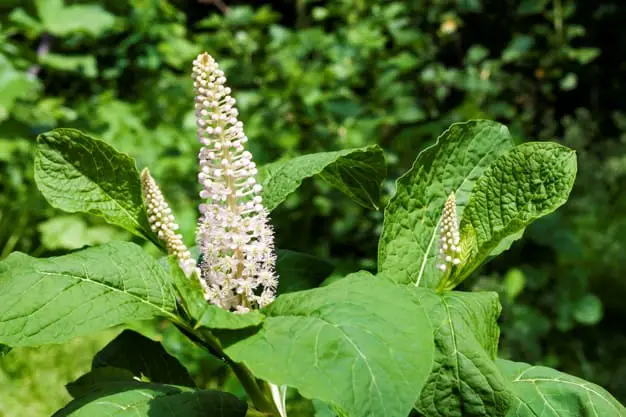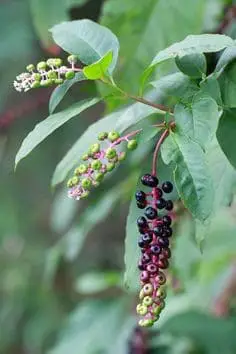Contents

Pokeweed is a poisonous perennial weed that is difficult to get rid of. Once it begins to shoot in your garden, other gardeners will tell you that you’re in for a lot of work.
This resilient weed is easily identifiable by its enormous, fleshy, and white taproot, its smooth succulent stem that is either green, red, or purplish. its simple lance-shaped leaves, and finally, its green or white flowers that produce dark purple berries for birds and other animals that are unaffected by its toxins to eat.
There are several names this weed goes by, some of them are American nightshade, garget, pokeroot, pigeonberry, inkweed, coakum, and Virginia poke. There are multiple other names but these are the most commonly used terms.
This weed is native to the eastern part of the US and it can be found on most reduced tillage fields, pastures, open woods, and gravelly soils. This weed survives for two main reasons. The first being that it can grow in plant hardiness zones 2 to 11, and the second being that it reproduces very quickly.
Pokeweed reproduces using its seeds. A little fun fact to note is that a single pokeweed plant can produce about 50,000 seeds throughout its lifespan. Each seed remains viable for about 40 years. These seeds are often propagated by the birds and animals that feed on the pokeweed plant, those that are immune to its toxins.
Good to Read : How To Make A Homemade Weed Killer?
The Toxicity of Pokeweed and its Impact on Animals

Several toxins have been found in large concentrations around the roots, berries, and seeds of pokeweed. These toxins include phytolaccine, an alkaloid, phytolaccigenin, a saponin, phytolaccatoxin, a resin, and lectin, a protein. Lectin is very useful to legumes because it binds nitrogen-fixing bacteria within their roots.
When livestock and humans consume the weed, it can cause a burning sensation in the stomach which is led by nausea, puking, diarrhea-ing, and in extreme cases death. The plant protein, lectin, that is found in pokeweed causes red blood cells to agglutinate, that is, clump together. It may also cause an abnormal cell division in lymphocytes.
Victims of this plant begin to formulate excess saliva, intense sweating, blurred vision, a weak pulse, paralysis, and shallow breathing.
Getting Rid of Pokeweed
To get rid of this plant, you’ll need the following tools:
- Shovel
- Spade
- Bow rake
- Rototiller
- Garden hoe
- Glyphosate herbicide
Before I go into detail about how to get rid of them, you should know that it’s a continuous process and it doesn’t just happen overnight. With that being said, let’s move along.
Uproot the small, new shoots first
The first step for getting rid of pokeweeds is to tackle the new shoots first. They are easy to pull out by their roots, just as you would harvest a carrot. Ensure that you firmly tug on its base so the entire roots can be removed from the soil. Else, a new plant will just spring up from that spot.
To be honest, this is easier done in light soils such as sandy and loamy soils. Clay soil is much compact and more difficult to uproot from.
Next, tackle the larger plants
Since it will be very difficult to uproot the larger pokeweed plants by hand, you’ll have to make use of some tools to dig out their taproots. A spade will be a very efficient option. Simply dig a circle that’s about 12 inches deep and wide around the base of the pokeweed. To pull it out, use your spade. Ensure that you are able to pry out the entire roots from the hole that you dug so they do not regerminate. This job requires some heavy muscle.
Make use of your rototiller
Your rototiller is what you’ll use to loosen up the soil and get all of those extra root pieces lying around. We definitely do not want those pokeweeds poking their ugly heads anywhere ever again. So, to fulfill safety protocols, inspect your rototiller for any damages. If safe, prep your rototiller, ensuring that it’s good to go. Then, with a firm grip on the handlebars let it do its work.
The Earthwise electric tiller is a highly recommended option, as it can till soil to about 16 inches wide and 8 inches deep. Other notable mentions are the Mantis tiller cultivator that tills a 9 inches wide and 10 inches deep space, and the Yardmax tiller that tills up to 21 inches wide and 11 inches deep space.
A quick tip for tilling is to till dry soil as tilling wet soil clumps it up. Thus, defeating the purpose of loosening the soil.
Rake and dry them up
Once the soil has been loosened, it is easy to run a rake through it to get all those root pieces lying around. Gather them all on a tarp or surface that has no soil on it and leave them out in the sun to dry. Once dried, they’re dead and can be put in a compost bin. However, ensure that they are only placed in the compost bin when they’ve dried so they don’t spring up somewhere else.
Make use of a glyphosate herbicide
In extreme cases, you might need this. Compare-N-Save’s herbicide is a killer option. The best method of application is to insert the top of the shoots in a container filled with three percent glyphosate herbicide. This is because the chemical will be absorbed from the top down to the roots through the stem, thus killing every part of the plant. You can choose to insert the shoots for as long as two days if you’d like. It kills them faster. Once the plant has been killed in about two weeks or less, dig it up.
On that note, to conclude this article, you should remember that getting rid of pokeweeds is a continuous process and that you’d have to keep up with the process because the pokeweed seeds have a long lifespan making them difficult to get rid of overnight.
Good to Read : How to Use Borax Effectively in your Garden
Want to know more about gardening ?
Fill in your email address in the form below and you'll receive all the latest updates directly in your in-box.
Thank you for subscribing.
Something went wrong.